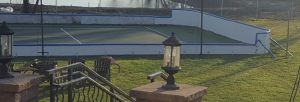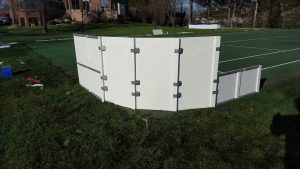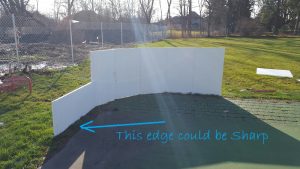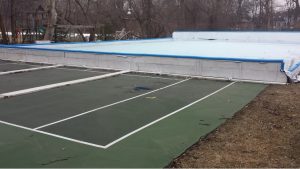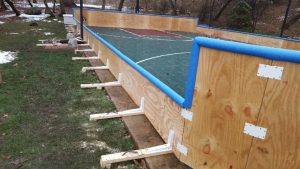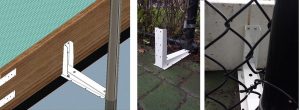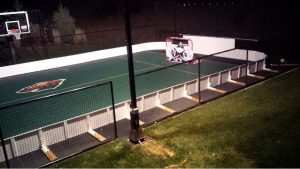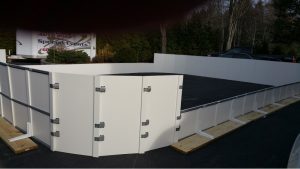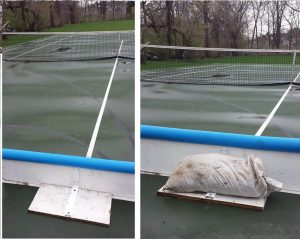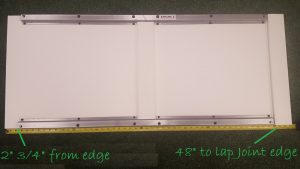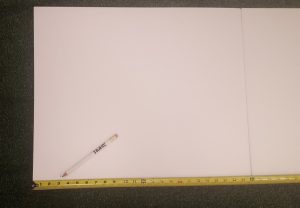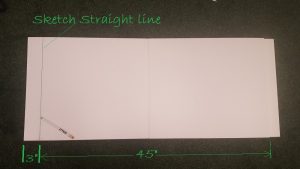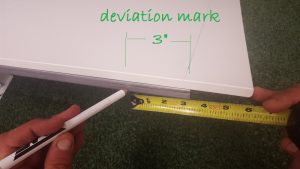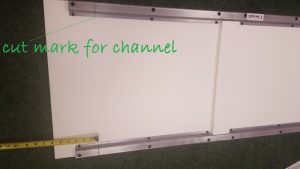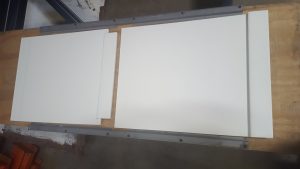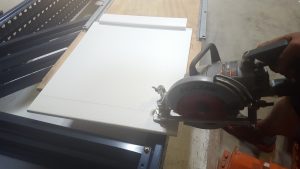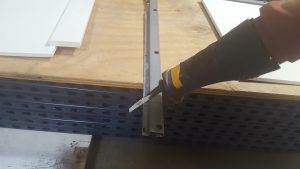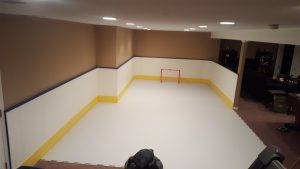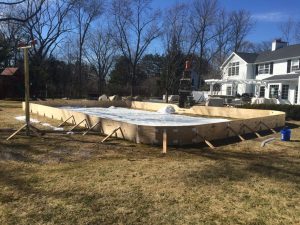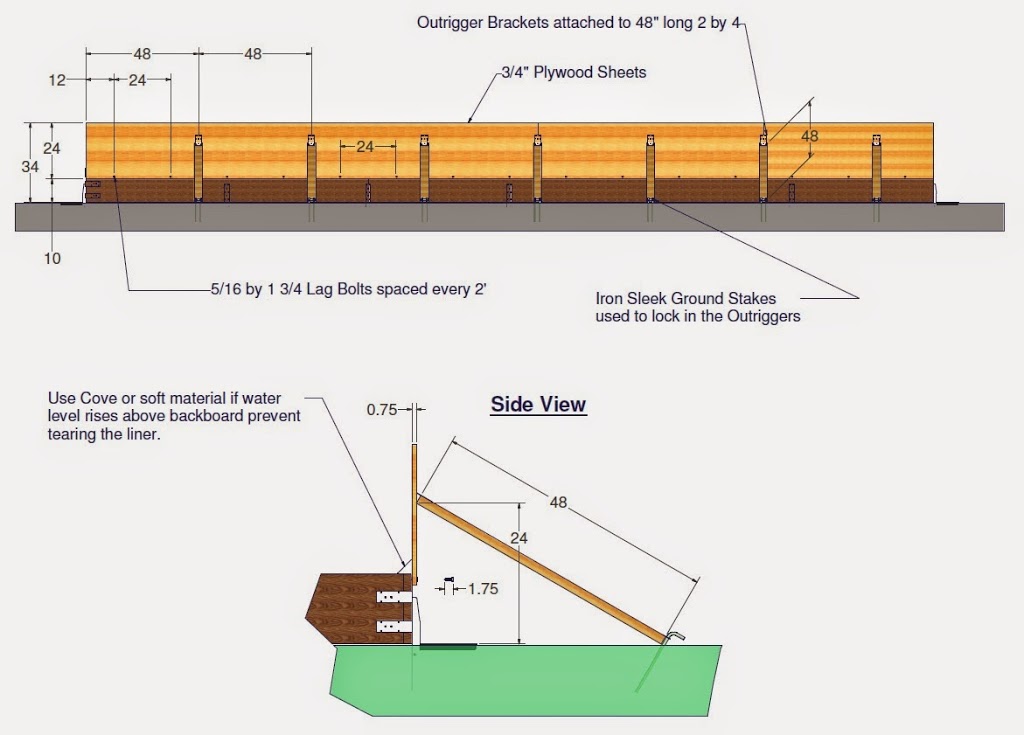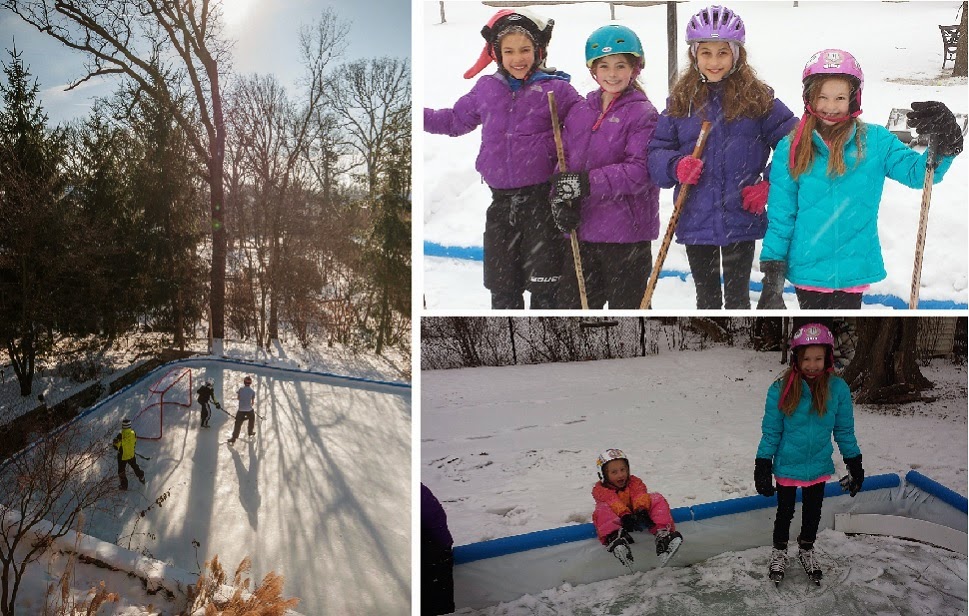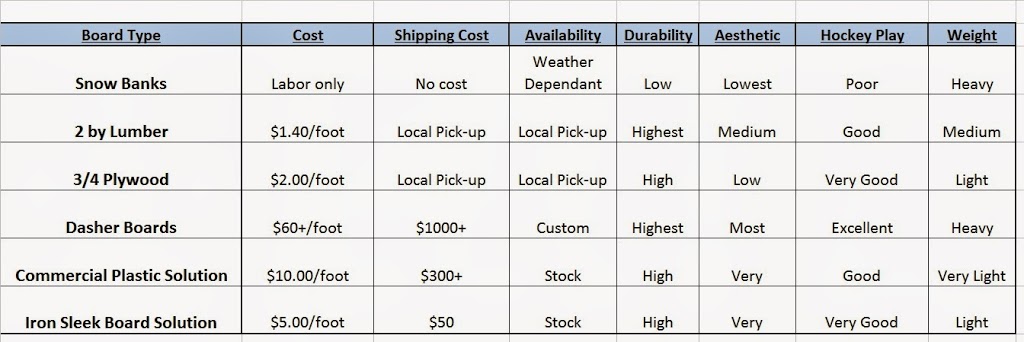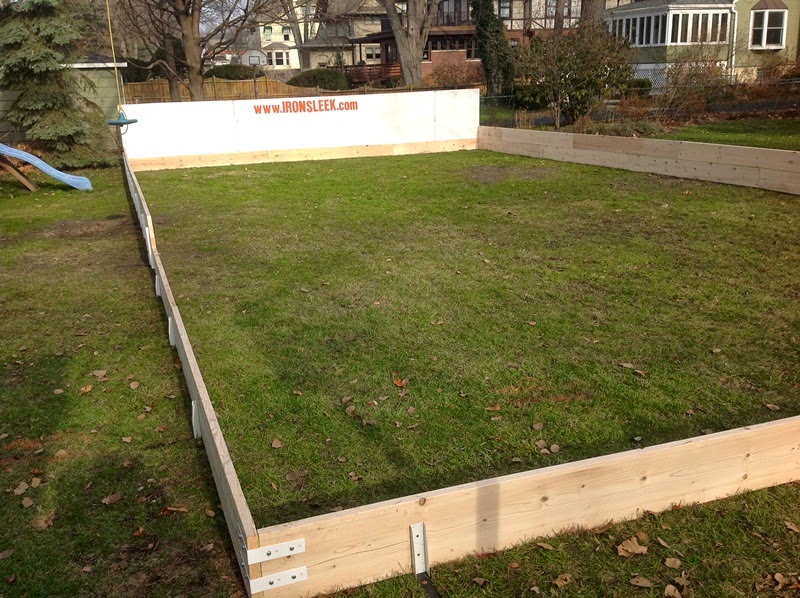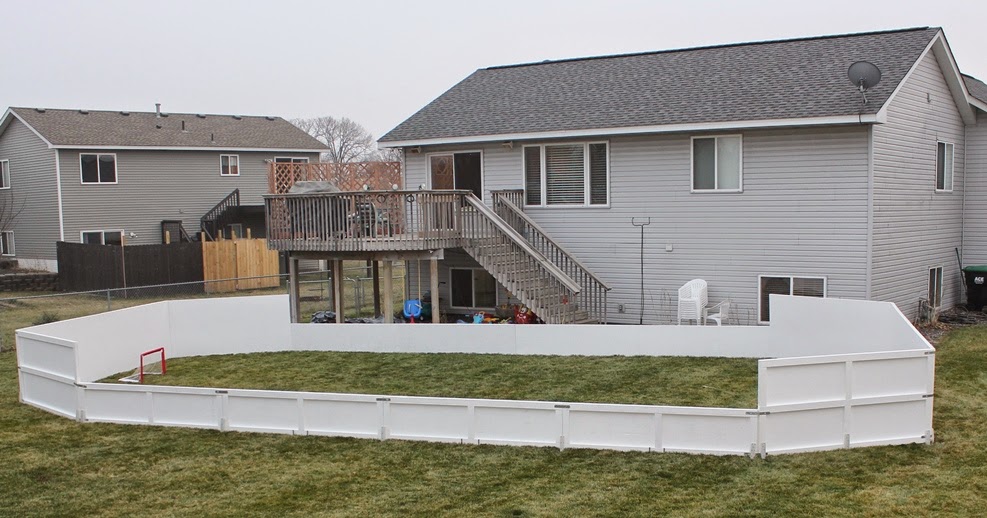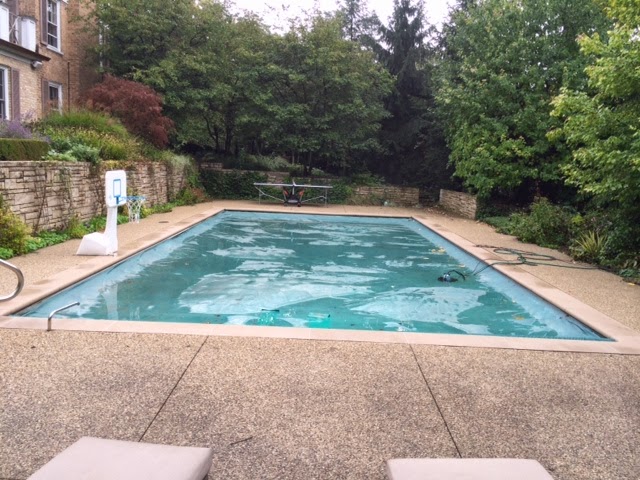How to cut an Iron Sleek Poly Steel Board
Step 5: With the board panels already marked and the steel channels already marked. Disassemble the channels from the boards.
Step 6: Cut the marked panel with a circular saw using a wood cutting blade. For best results you can use a table saw.
Step 7: Cut the 2 marked rails with a reciprocating saw, chop saw, or hand hack saw.
Step 8: After all the pieces are cut, you can chamfer or route cut edge of poly panel and file off sharp corners on the cut edge on steel channel.
Step 9:Now simply reassemble board components. Be sure to not spin out black mounting screws when reassembling. Your board should be your desired length. For this example it will be 45″
Check out this basement shooting lane. With the this ability to cut we were able to wrap around our customers basement to optimize the provided space.
Backyard Rink, Time to tear it down for Spring!
There are 2 reasons to hold off on draining your water. First, exposed water on a rink picks up kinetic energy from the wind to instigate the melt down. This makes a huge difference. Moving water melts ice so puddles on top of your ice will help to melt it, even at night. Keep the water in the rink. Second, the water temperature will rise faster than the ice temperature. Ice gets stuck at 32°F until it gains enough heat to convert to water.
This is the only time your white Iron Sleek liner is going to work against you. Since you have already had a season as manager of your rink, you know quite well that a leaf burns its way to the bottom of a rink. Consider placing a dark colored tarp on ice sections to gain solar energy.
The best way to remove water is with an electric or gas pump that has a discharge hose. Your local home improvement store usually rents them out. As a reference point, a 30 GPM pump will empty a 20×46 rink in 2-3 hours. With a pump arrangement, you have full freedom to direct the water to areas that are suited for drainage…like the city sewer. If you cannot reach the city sewer, you will need to direct the water toward a safe and convenient draining area.
Siphoning is slow but it works well. With siphoning, you will have some flexibility on directing the drainage. My warnings are that it will take several hoses to get a decent flow and that starting the suction takes some strong lungs. A benefit of siphoning is that the low flow rate gives the ground a better chance to absorb the water.
At the high water corner you can open your rink to let all of the water flow out. This is the fastest way to drain your rink. I have done it this way for years, but I did notice that is has some negative effects. Over flooding the grass can damage the grass roots. Also, repeated flooding can lower your ground’s grade.
If you need a piece of liner to cover your lumber, now is the time to cut that piece out.
Click here to read blog on rink improvements for spring.
Create The Perfect Backyard Rink With Iron Sleek Ice Rink Liners
Creating the perfect backyard rink hinges on a host of key factors. Picking the best spot on your property, using a top quality kit, and accessorizing as needed are just some of the important factors to consider when you begin your build. Another critical detail to keep in mind when you move forward with your arena is choosing the right ice rink liners.
Iron Sleek Offers Top Quality Ice Rink Liners For Your Build
If you are searching for top quality ice rink liners to finish your backyard arena, look no further than Iron Sleek. Here at Iron Sleek, we pride ourselves on providing our customers with premium ice rink liners for a perfect final fit and finish. When using our ice rink liners, you will enjoy a wide range of distinctive features that will enhance the overall performance of your arena.
Experience The Iron Sleek Difference For Yourself
What are some of the key distinctions that an Iron Sleek rink offers? The first thing you will notice is the top quality material that we use on all of our ice rink liners. Every product uses only virgin polyethylene plastic resins. No inferior fabrics and provisions; no recycled materials and no add on consumer products; only premium components to ensure you receive a highly durable, 100% watertight final product.
Beyond quality materials, we also only offer white liner products. Many of our customers initially assume that the color of the product does not make a difference. However, our team educates our customers to help them understand the benefits offered by white materials. Dark liner colors and even clear liners can absorb extra heat and potentially melt your rink on warm, sunny days. A white liner will reflect solar energy and protect the performance of your arena.
Another major differentiating feature when purchasing one of our ice rink liners is the extensive sizing selection. With our sizing selection you be sure to have enough liner to cover your entire rink while still not over buying. This help to keep things economical. Our liner sizes are smart so that waste is minimal. Iron Sleek liner widths and cuts work awesome with nominal lumber, plywood, and our poly-steel boards.
Most importantly, when teaming with Iron Sleek, we offer extensive instructional resources to our clients. We firmly believe that building the perfect backyard arena should be fun and easy, not daunting and stressful! That’s why we offer instructions and video clips that can take you step-by-step through every phase of the process for the ultimate ease-of-use experience from start to finish.
Contact Iron Sleek Today For More Information
Want to hear more about how Iron Sleek can help you create a backyard arena that your neighbors will envy? Contact our team today at 877.825.2334 and connect with a specialist now!
Backyard Ice Rink Kits: Six Tips To Buying The Right One For Your Family
Looking for fun and creative ways to use your yard during the cold winter months? Backyard ice rink kits can deliver an ideal option. Well-built backyard ice rink kits can easily transform your snow-covered yard into a fun ice-skating arena that everyone in the family will enjoy.
When you’re ready to move forward with purchasing backyard ice rink kits, it’s important to know what to look for to ensure you receive a premium product that will suit all of your needs. There are many providers to choose from; knowing six important tips will help you weed out non-viable vendors and find the perfect option for your family.
Tip #0: Team up with a product supplier who are backyard experts
Many tarp or liner suppliers actually know nothing about rinks. It is just a seasonal hobby for them. They will buy the cheapest supplies trying to make a quick buck in the winter. Choose a company whose passion and knowledge is outdoor rinks. The company you choose should become your consultant. Building a rink could be tricky, be sure the company you buy from is your rink building teammate.
Tip #1: You Should Have Options
Are you looking at various vendors who offer backyard ice rink kits, but feel like your choices are very limited? Or, do you feel like you’re being forced into decisions that aren’t quite a perfect fit for your family? Move on; a quality provider of premium backyard ice rink kits will offer a comprehensive range of product options and sizes. Having options available means that you can select the right model to fit both your backyard, your skaters’ needs and your budget.
Tip #2: Look For Money And Time Savers
Outdoor ice-skating rinks should not drain both your time and financial resources. Established vendors will offer various kits and products at affordable pricing. Best of all, an experienced vendor will create kits designed specifically to save you time.
Tip #3: Get Everything You Need In One Package
Some providers offer a la carte shopping for each individual item needed for installation. The result? You spend more than you need to setting up and you waste precious time purchasing every single component you need separately. When shopping, choose vendors that offer all-inclusive backyard ice rink kits so you know you will have everything you need in one package.
Tip #4: Consider Materials Used
Your outdoor rink needs to be strong and durable to ensure it withstands everything you and your little skaters dish out over the year. Don’t settle for a design made of subpar materials or a homemade recipe. Find options that offer a steel design. Steel backyard ice rink kits deliver superior performance and endurance, making them an ideal choice for homeowners.
Tip #5: Have Room To Grow
Sure, a smaller ice rink may suit your family’s needs now. But, what happens when everyone starts to grow? Will your ice rink be able to grow right along with you? If not you may find yourself starting over and having to purchase an entirely new set at some point. Don’t waste money starting over. Look for a kit that is expandable, so your rink can grow along with your family.
Tip #6: Look For Customization Accessories
Once again, settling for one-size-fits-all kits is not the answer. Instead, search for vendors that offer accessories that complement their designs. You and your family can select various items to customize your rink as only you can.
Have questions about quality backyard ice rink kits? We have answers. Contact Iron Sleek today to hear more!
Get Outside and Active This Winter with Backyard Rinks
It’s no secret that staying active throughout the winter months can be a challenge for any family. It seems like the colder it gets, the easier it is for us to stay inside until we eventually go into a quasi-hibernation mode, complete with comfort food and lots of television. If you’re tired of hunkering down at home during the winter months, you just may be an ideal candidate to install backyard rinks on your property.
Backyard Rinks: Versatile, Convenient And FUN
Homeowners who install backyard rinks instantly notice an impressive range of benefits. The first thing that many notice after installation is just how much everyone in the family wants to use it! Kids and adults alike love the opportunity to simply lace up their skates and hit the ice. Not only will you get extensive use out of it, but it also provides the perfect excuse to get outside and enjoy some fresh, albeit chilly, air.
Beyond extensive use, backyard rinks also provide an excellent opportunity for you and the whole family to get outside and stay active. In many families, when the temperatures go down, the dependence on electronic devices goes way up. Many parents struggle to find ways to get their little ones moving and staying healthy. A backyard arena allows them to build up some cardiovascular endurance and stay fit no matter how much snow comes.
What is another reason why you will love your personal skating arena? It’s a great way to spend time together as a family. Sometimes winter fun together can be challenging. With so many different ages to accommodate, finding an activity that everyone can do and actually enjoy can be tough. Backyard rinks are a great way for skaters of all ages and with every ability level to spend time together, right in your own yard.
Speaking of right in your own yard, skating arenas are extremely convenient. Yes, having a public rink in the vicinity does offer some skating opportunities. However, you have to work around their timetable. Open ice time can feel few and far between when you and your family are trying to make it work with your busy schedules. A personal arena means you can conveniently skate whenever you want.
Sharpen Your Skill Set Or Just Play On Your Backyard Rink
Best of all, backyard rinks offer homeowners the opportunity to use them as formally or as casually as they would like. Have competitive skaters and/or hockey players in your home? They will love working in their own yards to sharpen their existing skills and raise their talent levels at their own pace.
Prefer to keep things casual during rink time? Not a problem; many homeowners simply use their arenas to let their children enjoy unstructured playtime. Sometimes that may mean organized pickup hockey games with the neighbors. Other times it may mean letting the kids outside to make up their own games and competitions.
Want to hear more about our premium quality outdoor ice rink products? Contact Iron Sleek today!
Top Ways Iron Sleek’s Ice Rink Liners Stand Apart From Other Products
Buying a backyard ice rink is an exciting time for any homeowner; it’s the perfect way to pass time throughout the winter months with the kids and stay active as the temperature drops. However, with the excitement of a new rink comes yet another decision to make when trying to find the right ice rink liners to use on your system. There are many options, both in retail stores and online. How can you be sure that you are picking a winner?
The CHEAP and EASY way to add backboards to your backyard ice skating rink!
First, let’s assume you have a 2’ by lumber skating rink frame.
Step 1-Build your rink frame just as you always have. No extra money required and no extra effort.
What should I use as RINK BOARDS for my Backyard Skating Rink??
The beauty of smooth shiny ice under the clear evening moonlight and the crisp sound of skates cutting ice with the playful laughter of children and the aroma of fresh burning logs in the background air are definitely impressions that stick when we think of our backyard rinks…truly EPIC!!
All this is possible because a containment holds water in place allowing it to transform to the expanding miraculous ice when the ambient sinks below 32 degrees. The containment has a great function but it also adds character and personality to an outdoor rink. There are many materials that are commonly used to contain water to form an outdoor rink. Some options for rink boards are: dashers boards, 2” by lumber, plywood, commercial plastic, and snow banks. These are all good options but it is up to the rink designer to choose between cost, effort, aesthetics, and their overall vision for the rink. The chart and dialog below is a good starting point to understand some of the differences between the various options.
Let’s start with the most deluxe…Dasher Boards.
Real hockey dashers are rigid metal frames, 48” tall, with ½” poly permanently attached to the frames that can sustain rough hockey play. Dasher boards are usually permanently mounted, heavy, and require construction professionals for installation. They are usually well decorated with a base trim and a colored top ledge. There are companies in Canada and the US who have mastered this mainly commercial market. Heavy duty, metal framed dashers with ½” poly boards cost over $100.00 per linear foot. There are custom wood frame options starting at $60 per linear foot or aluminum frame options that start at $30 per linear foot. Iron Sleek does not provide dashers but we would be happy to discuss other cost effective board solutions for you that could make your rink board look and play like dashers.
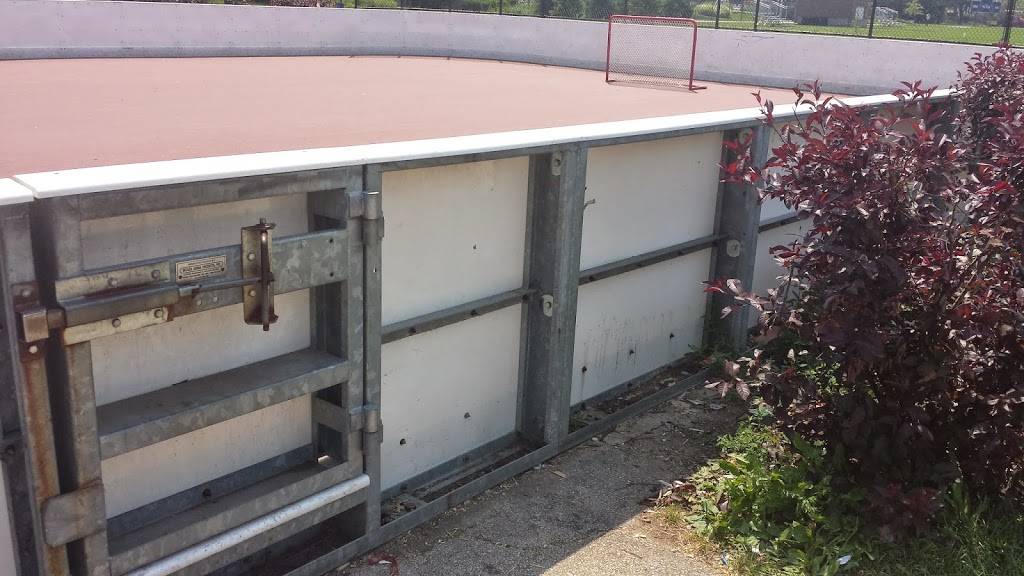 |
| Steel Framed dashers with 1/2″ Poly |
“2 by” lumber is a great choice for building a skating rink. 2 by 12’s or 2 by 10’s are readily available in both Canada and the USA. In Canada, 2 by 10’s are best the value. Contrarily, in the US, 2 by 12’s are more favorably priced. There are many benefits for using 2 by 12 lumber for rink boards. 2 by 12’s come in a wide range of lengths so our customers can build a rink without a single cut. Also, 2 by lumber comes in very long lengths. Our local lumberyard even has 20 footers. With 20 foot boards, Iron Sleek’s 20 by 20 rink kit could be built with just 4 boards…No Seams! Just as an FYI, most of our customers who use 2 by 12’s buy them in 10 foot length as they fit just perfectly in a minivan. Some other benefits are that 2 by lumber is durable, easily stacked to build a 2nd story with the Iron Sleek extension bracket, and is the most cost effective solution for building a basic rink enclosure. 2 by lumber is also a tough construction material as it is strong enough so fewer Iron Sleek brackets could be spanned across the boards. Another benefit of “2 by” lumber is that it is milled with a radius edge which helps prevent liner cuts where plywood has a sharper splintery edges. Some short comings on using lumber for an outdoor rink is that that lumber is heavy and sometimes boards can warp if not stored properly. Iron Sleek base cove works out great for to fill the gaps on warped boards. Some other challenges with 2 by lumber is that the boards are heavy, they can split along the grains, and they can warp with time. All in all, for about $1.25-1.50 per foot investment, 2 by lumber is a great inexpensive solution for building a skating rink. Some tips on using lumber:
· Be careful to not miscalculate lumber sizes. “2 by” lumber is just a nominal size. The actual thickness of the lumber is only 1 ½”. The same is true for the height. For example, a 2” by 12” is acutally 1 ½” by 11”.
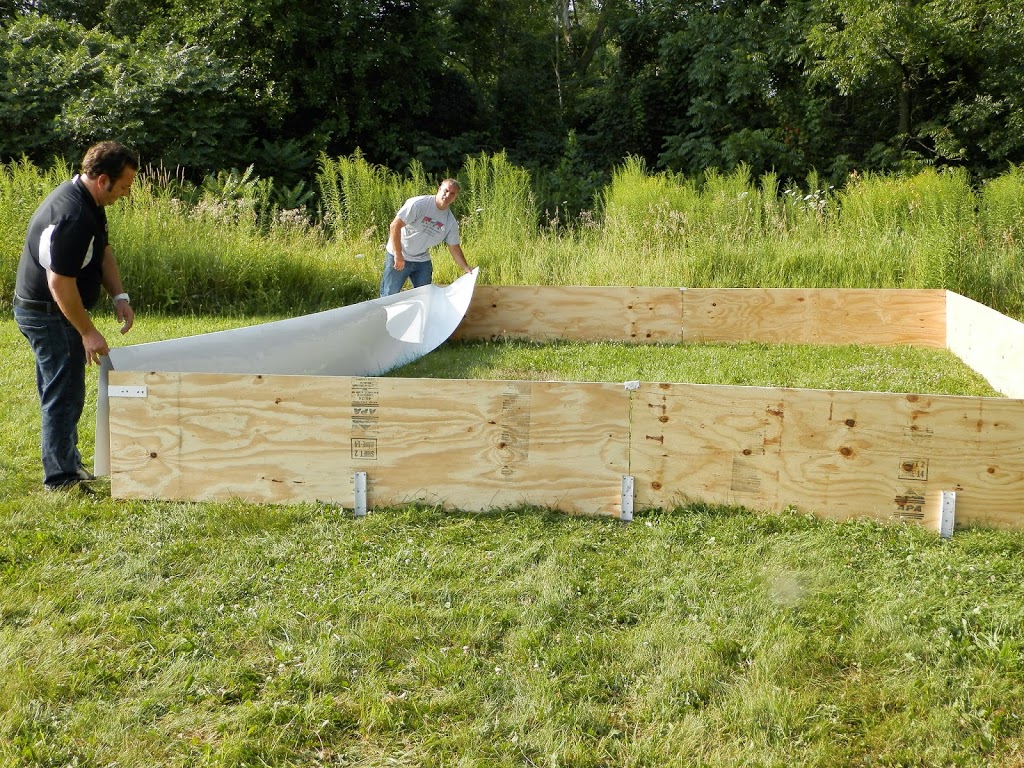 |
| STEP 2 |
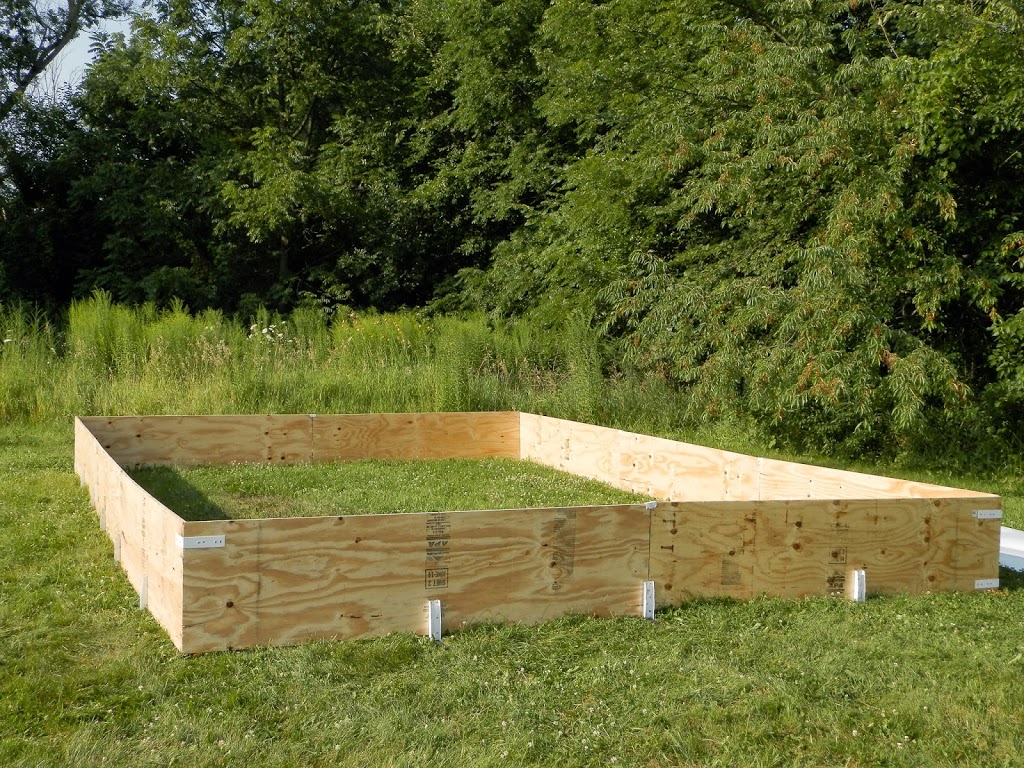 |
| STEP 1 |
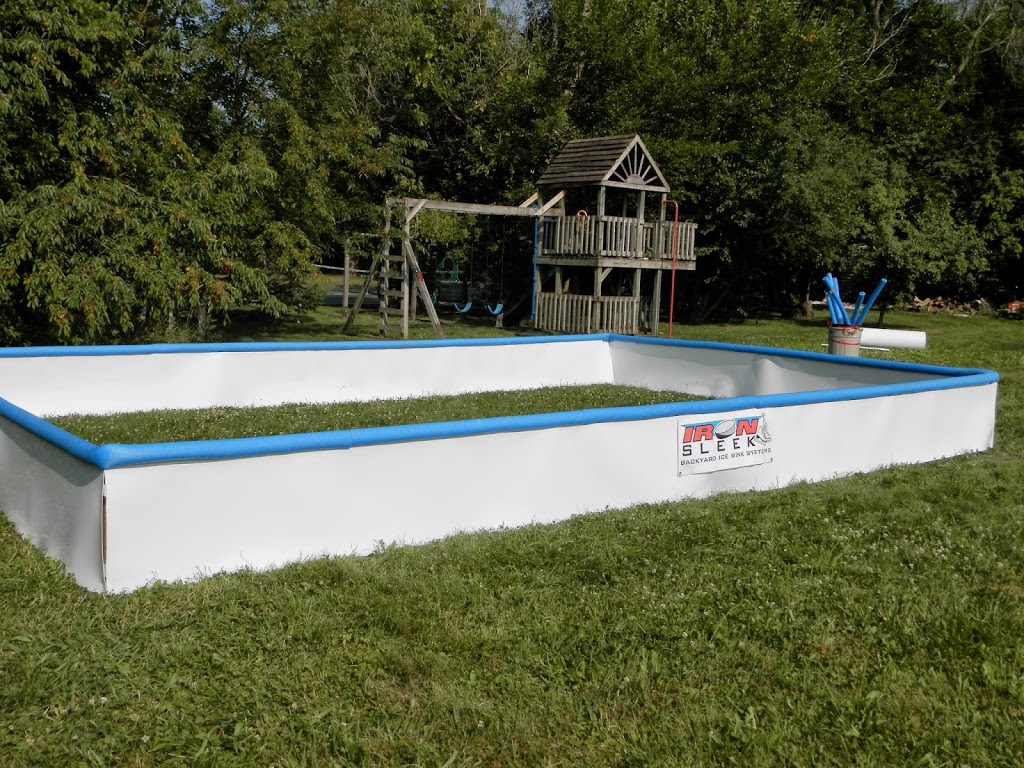 |
| STEP 3–PLYWOOD TRANSFORMED |
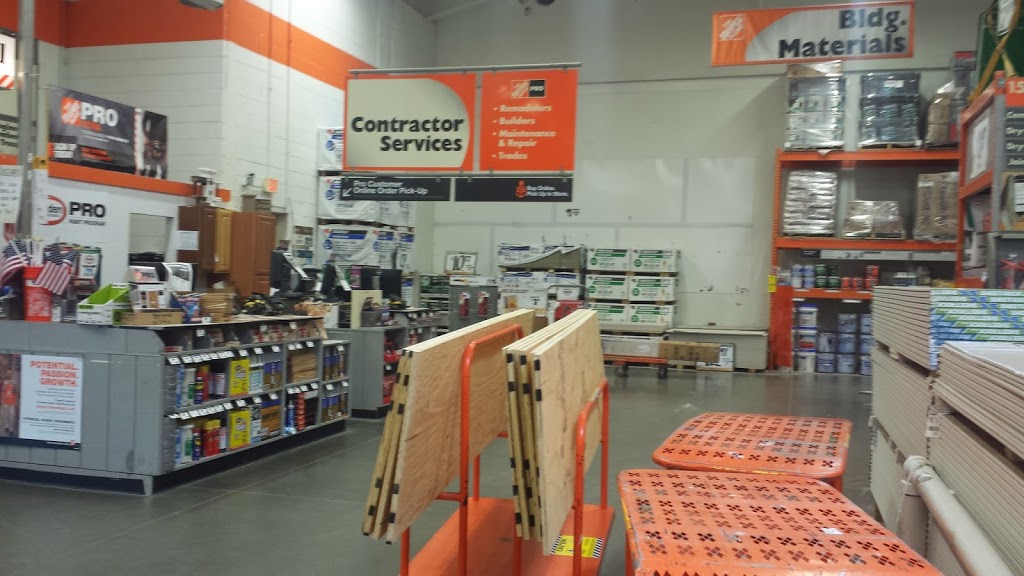 |
| Materials store can cut the lumber |
Some of the challenges with plywood are:
· Plywood sheets must be ripped. I recommend asking your lumber provider to rip the plywood or you will be stuck with a time consuming tedious job of sawing. Sometime lumber yards rip plywood at no cost. In Chicago, Home Depot will rip up to 10 boards at no cost.
I built my first rink 20 years ago with snow banks. 20 years ago, I quickly learned that snow banks are not a reliable way to contain an ice rink using the liner method. The main reason is that the snow will melt on a mild day and your rink will soon wash away. Also, when you are filling your rink, the snow bank will start to melt from the warmer water. Yes, snow is free, but if you are serious about having a backyard family rink, choose a construction material as a rink board. Snow banks are exhausting to maintain; however, they are still commonly used on ponds as it is difficult to bring construction materials to the edge of a lake. Iron Sleek has simplified building a rink on a pond and has provide an alternative to snow banks with the Iron Sleek Pond Bracket. See video below:
Can I build a rink over my in-ground pool?
Can it be done?
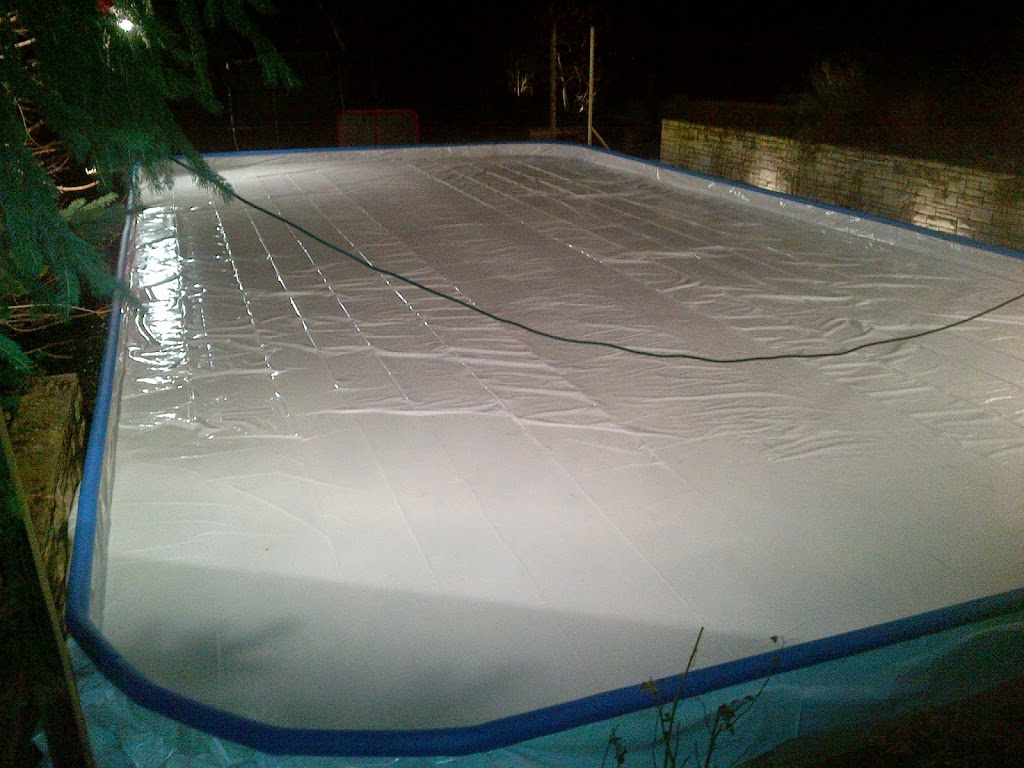 |
| Rink enclosure above pool ready for fill up! |
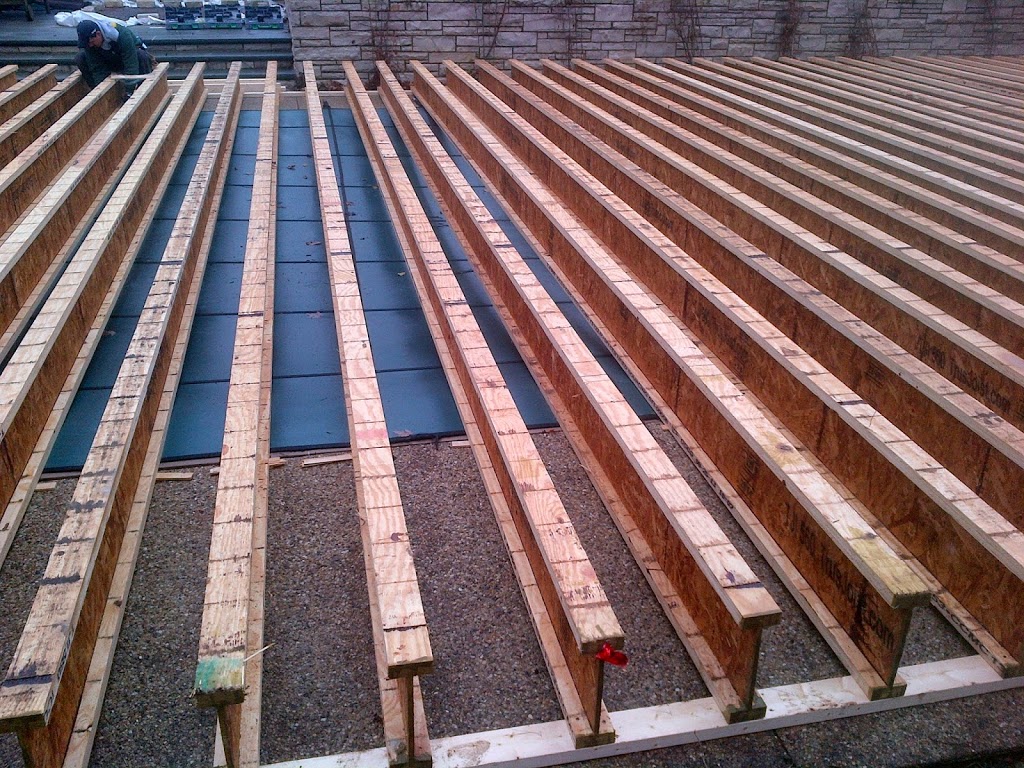 |
| Engineered stage |
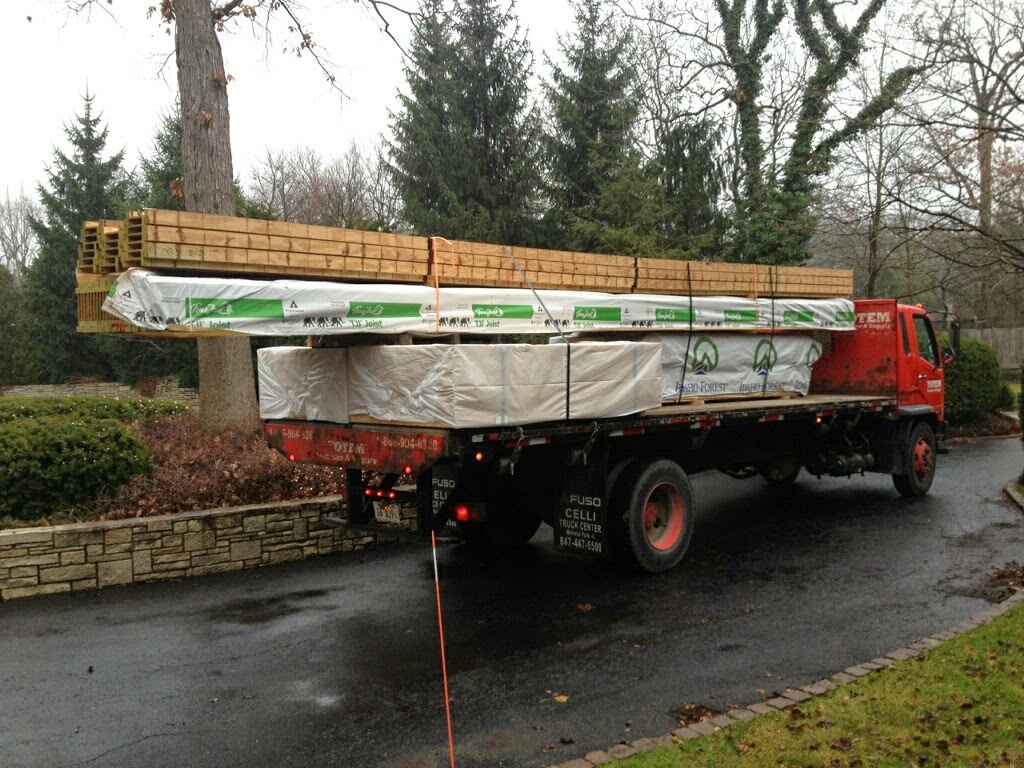 |
| Material delivered |
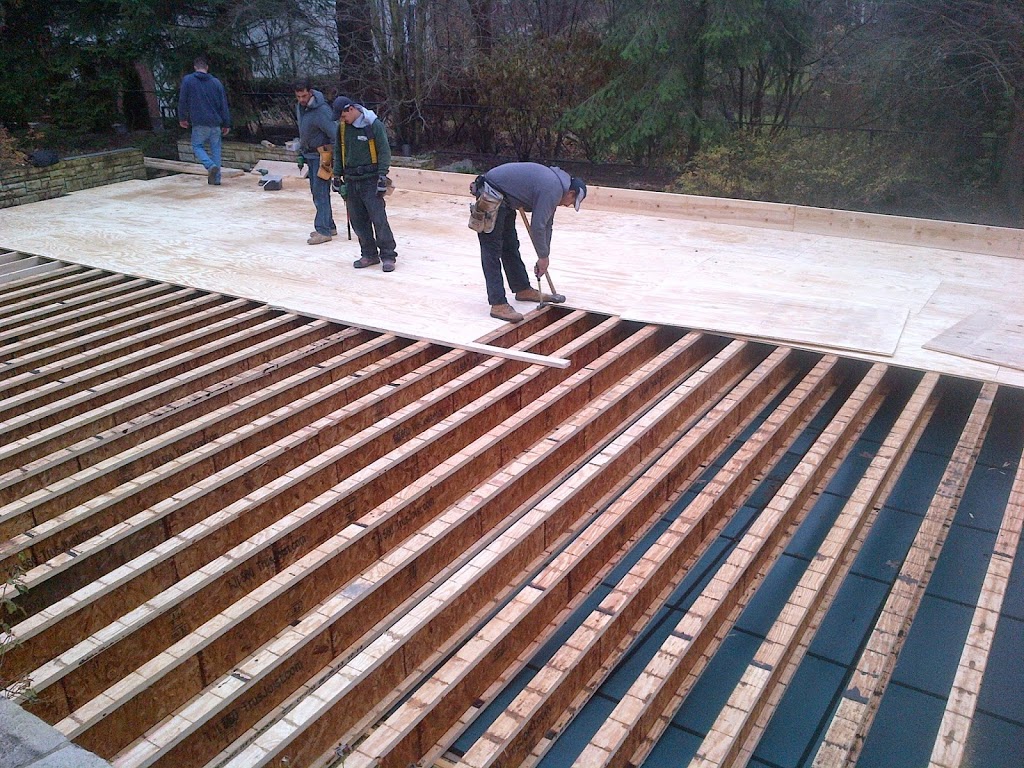 |
| The labor effort |
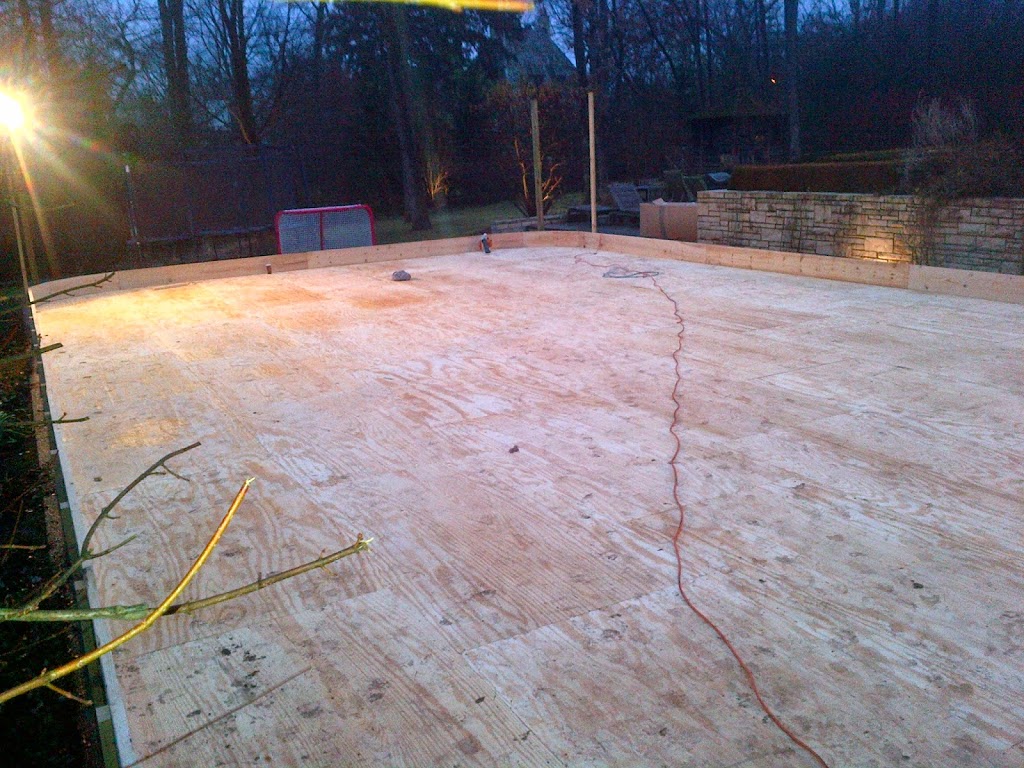 |
| Stage is built, ready to become a rink!! |
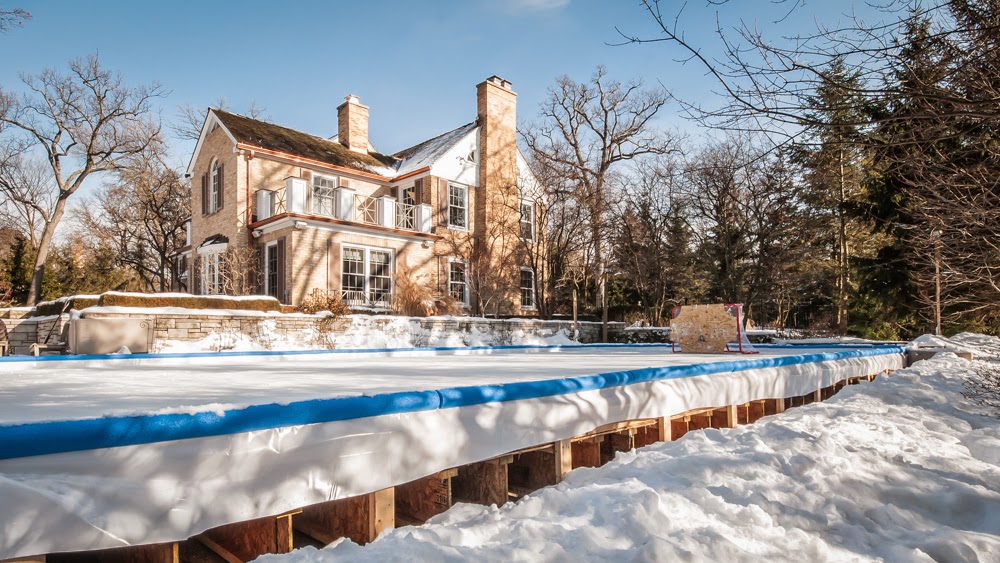 |
| Transformed!! |
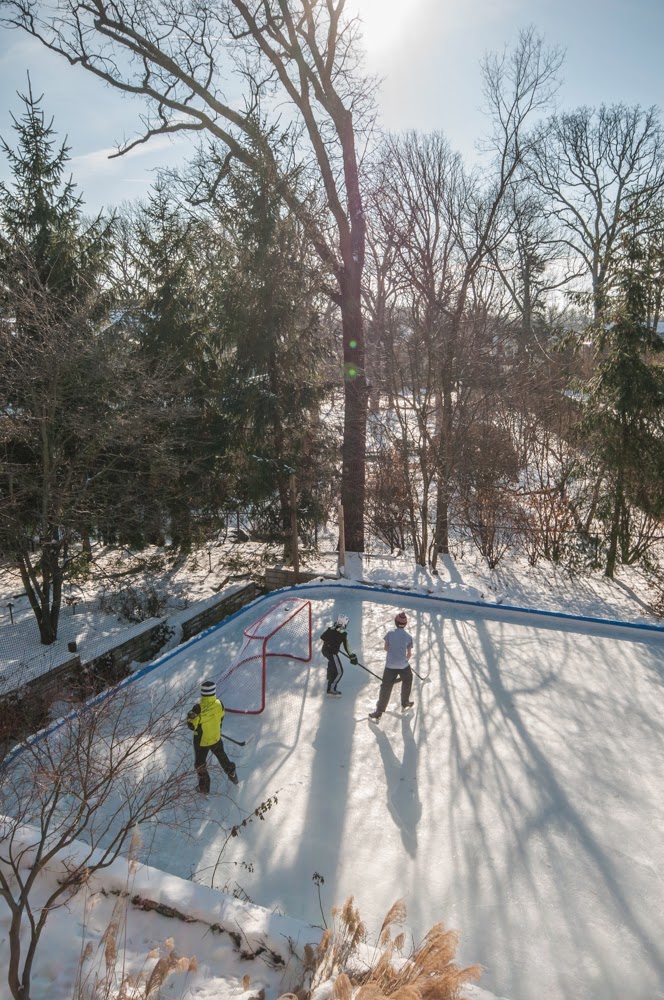 |
| Pristine ice above the Pool!! |
-If your yard is severely sloped and the only flat area you have is the pool area, you may want to price this out.
Opportunities
-The stage is not a complete sunk cost. It should have resale value to a local ice rink installer. Refrigerated rink are often build on platforms.

